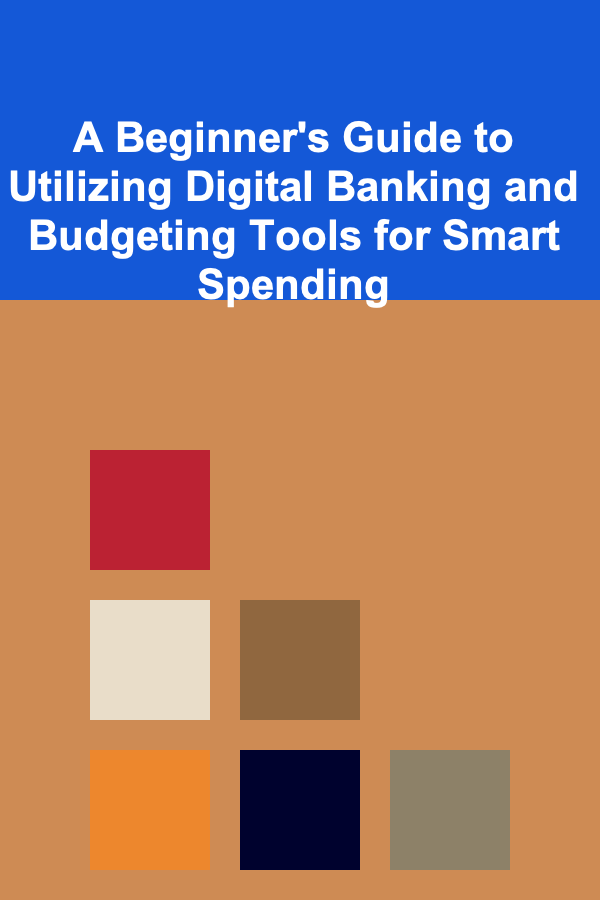
A Beginner's Guide to Utilizing Digital Banking and Budgeting Tools for Smart Spending
ebook include PDF & Audio bundle (Micro Guide)
$12.99$6.99
Limited Time Offer! Order within the next:

In today's fast-paced digital world, managing your finances efficiently is more accessible than ever before. With the advent of digital banking and budgeting tools, the power to make informed financial decisions and track your spending is at your fingertips. Whether you're just starting out or looking to enhance your financial management, this guide will introduce you to the tools and strategies you need to take control of your finances and make smarter spending decisions.
Understanding Digital Banking
Digital banking refers to the use of online platforms and mobile apps to access, manage, and monitor your financial activities without the need to visit a physical bank branch. It encompasses a wide range of services, including checking and savings accounts, investment management, loan processing, and bill payments. Digital banks often provide a more streamlined and cost-effective alternative to traditional banking systems.
Key Features of Digital Banking
- 24/7 Access: You can manage your finances from anywhere, at any time, using just your smartphone or computer.
- Real-Time Notifications: Receive instant updates about your account balances, transactions, and bills.
- Low Fees: Many digital banks offer lower fees compared to traditional banks, as they often have fewer overhead costs.
- Advanced Security: With encryption, two-factor authentication (2FA), and biometric verification, digital banking systems provide a high level of security for your transactions.
Benefits of Digital Banking
- Convenience: Digital banking allows you to perform all your banking activities without stepping foot into a physical bank. This includes transferring funds, paying bills, and even applying for loans.
- Cost-Effectiveness: Many digital banks offer lower or no fees for various services, such as account maintenance, ATM withdrawals, and international transfers.
- Speed and Efficiency: Transactions are processed quickly, and many digital platforms allow you to automate bill payments, fund transfers, and even savings goals.
- Better Tracking and Insights: Digital banking apps provide detailed transaction histories and spending reports, making it easier to understand where your money goes.
Getting Started with Digital Banking
If you're new to digital banking, getting started is relatively easy:
- Choose a Digital Bank: Research different digital banks and their offerings. Look for features such as low fees, strong customer support, and a user-friendly mobile app.
- Open an Account: Most digital banks allow you to open an account online in a matter of minutes. You'll need basic information such as identification, address, and sometimes a credit check.
- Link Your Accounts: After opening an account, link your existing checking or savings accounts, credit cards, and other financial accounts for easy tracking.
- Explore the Features: Familiarize yourself with features such as direct deposit, bill payment, and transaction categorization. Make sure to enable notifications so you're always updated on your financial status.
Using Budgeting Tools for Smart Spending
Once you've set up your digital banking account, it's time to integrate budgeting tools into your financial management strategy. Budgeting is the cornerstone of smart spending, and there are several digital tools that make it easier than ever to track your income, expenses, and savings goals.
Popular Budgeting Tools to Consider
- Mint: Mint is a widely popular budgeting app that allows you to link all your financial accounts and track your spending in real time. It automatically categorizes your transactions and provides insights into your financial habits. Mint also offers alerts for upcoming bills and suggests ways to save based on your spending patterns.
- You Need a Budget (YNAB): YNAB is designed to help you assign every dollar a job, encouraging you to allocate funds to specific spending categories and savings goals. The app is great for people who want to gain better control over their finances and reduce financial stress.
- PocketGuard: PocketGuard is a budgeting app that helps you track your spending and find ways to save by showing you how much money you have available after accounting for bills, savings goals, and other recurring expenses.
- GoodBudget: GoodBudget is a digital envelope budgeting app, which allows you to assign cash amounts to different categories (envelopes). It's a great tool for people who prefer a more manual, hands-on approach to budgeting.
How to Use Budgeting Tools Effectively
- Link Your Accounts: To track your spending accurately, link your bank accounts, credit cards, and any other relevant financial accounts to the budgeting tool.
- Set Up Categories: Categorize your spending into different groups such as groceries, dining out, transportation, and entertainment. This allows you to see exactly where your money is going.
- Create a Budget: Based on your income and expenses, create a monthly or weekly budget. Allocate specific amounts to each category and try to stick to them. The budgeting tool will help you monitor whether you're staying within your limits.
- Track Your Progress: Regularly check the app to track your progress and make adjustments to your budget if needed. Many apps also provide insights into your spending habits, allowing you to identify areas where you can cut back.
- Set Goals: If you have financial goals, such as saving for a vacation or paying down debt, use your budgeting tool to track your progress toward those goals. Many apps allow you to set specific savings targets and monitor how close you are to achieving them.
Strategies for Smart Spending
Now that you're equipped with digital banking and budgeting tools, it's time to develop strategies for smart spending. The goal is not to limit your spending completely but to make informed decisions that help you live within your means while still enjoying life.
1. Track Every Expense
One of the best ways to manage your finances is to track every single expense. Digital banking tools can help you keep a detailed record of your transactions. Review your spending regularly to identify patterns and see where you can cut back.
2. Automate Savings
Set up automatic transfers from your checking account to a savings account or investment fund. Automating savings ensures you pay yourself first, before spending money on non-essential items. This simple habit can help you build an emergency fund or achieve your financial goals faster.
3. Limit Impulse Purchases
Impulse purchases can quickly derail your budget. To avoid them, consider implementing a "24-hour rule." If you're thinking about purchasing something on a whim, wait 24 hours before making the decision. Often, the urge to buy will pass, and you'll realize it wasn't a necessary purchase after all.
4. Look for Ways to Reduce Fixed Costs
Review your recurring expenses, such as subscriptions, utilities, and insurance. Are there any services you're paying for that you don't use? Can you find a cheaper alternative for certain expenses? Digital banking apps often provide insights into your regular payments, making it easier to spot areas where you can save.
5. Avoid High-Interest Debt
Credit card debt and payday loans often come with high interest rates, which can quickly spiral out of control. To avoid accumulating high-interest debt, try to pay off your balances in full each month. If you do carry a balance, look for a credit card with a lower interest rate or transfer your balance to a card offering a 0% introductory APR.
6. Plan for Big Expenses
Planning ahead for big expenses, such as vacations, home repairs, or major purchases, can help you avoid overspending. Use your budgeting tool to set aside money for these expenses over time, so when the time comes, you have enough saved up.
The Role of Digital Banking in Financial Education
Digital banking and budgeting tools also play a significant role in financial education. By regularly using these tools, you'll gain a deeper understanding of how money flows in and out of your life, helping you make more informed decisions about saving, spending, and investing. Many digital banks and budgeting apps also offer educational resources, including blog posts, videos, and webinars, to help you expand your financial knowledge.
Conclusion
Utilizing digital banking and budgeting tools is a powerful way to take control of your finances and make smarter spending decisions. By automating your savings, tracking your expenses, and using the insights provided by these tools, you can achieve your financial goals and live within your means. The key to success is consistency and making small adjustments along the way. Start today by exploring the tools available to you, and take the first step toward a financially secure future.

How to Maintain Your HVAC System for Year-Round Efficiency
Read More
How to Organize Craft Paper for Quick Inspiration
Read More
How to Organize Your Time Capsule by Year or Decade
Read More
How to Provide Your Pet with Indoor Enrichment Activities
Read More
How to Stage Your Bathroom to Create a Spa-Like Experience
Read More
Unlocking Success as a Teacher: A Comprehensive Guide to Teaching Excellence
Read MoreOther Products

How to Maintain Your HVAC System for Year-Round Efficiency
Read More
How to Organize Craft Paper for Quick Inspiration
Read More
How to Organize Your Time Capsule by Year or Decade
Read More
How to Provide Your Pet with Indoor Enrichment Activities
Read More
How to Stage Your Bathroom to Create a Spa-Like Experience
Read More